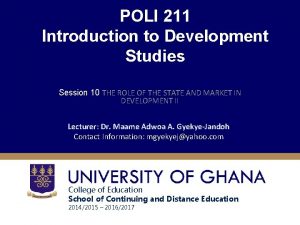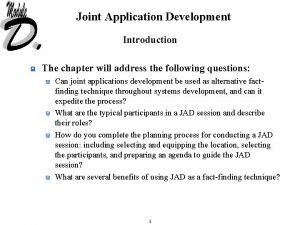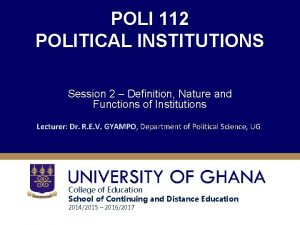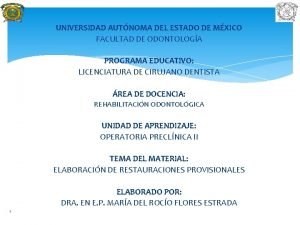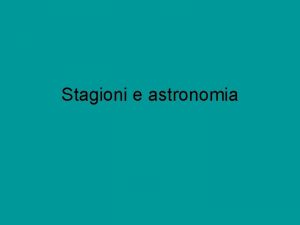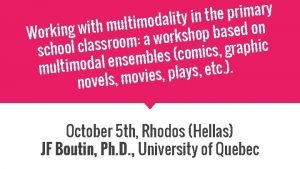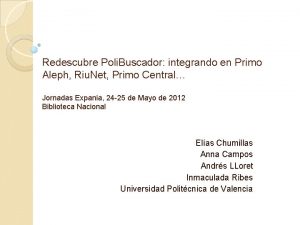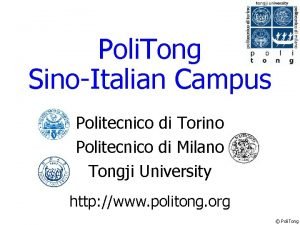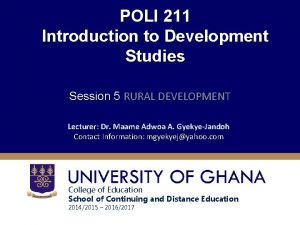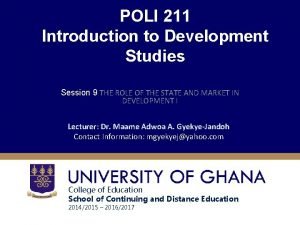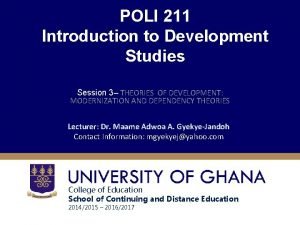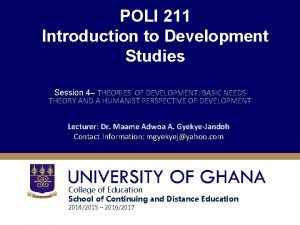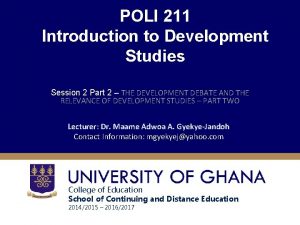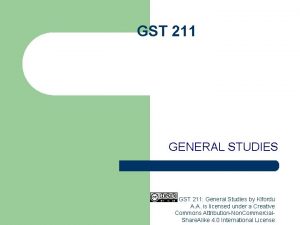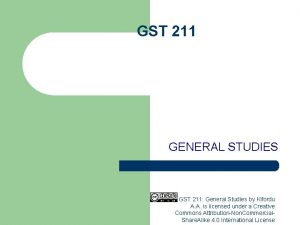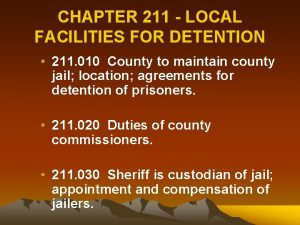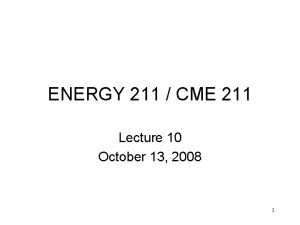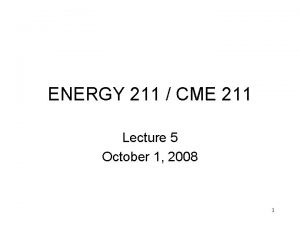POLI 211 Introduction to Development Studies Session 7






















- Slides: 22

POLI 211 Introduction to Development Studies Session 7 FOREIGN AID AND FOREIGN DIRECT INVESTMENT IN THE QUEST FOR DEVELOPMENT Lecturer: Dr. Maame Adwoa A. Gyekye-Jandoh Contact Information: mgyekyej@yahoo. com College of Education School of Continuing and Distance Education 2014/2015 – 2016/2017

Session Overview – Overview This session seeks to discuss the pros and cons of foreign aid and foreign direct investment. The student will become familiar with some of the major criticisms leveled against foreign aid policy, as well as the concept of foreign direct investment and the advantages it has for development of the less developed countries. Slide 2

Session Outline The key topics to be covered in this session are as follows: • Topic One: Foreign Aid: What It is and What It Does • Topic Two: Criticisms Associated with Foreign Aid • Topic Three: Praise for Foreign Direct Investment Slide 3

Reading List • Todaro, Michael. 2000. Economic Development. England: Pearson Education Limited. • Michael Todaro and Stephen Smith (2012). “Foreign Finance, Investment, and Aid: Controversies and Opportunities”. p. 684 -708. • Peter Bauer (1991). “Foreign Aid: Central Component of World Development? ” Slide 4

Topic One FOREIGN AID: WHAT IT IS AND WHAT IT DOES Slide 5

Foreign Aid: What It is and What It does • The terms Foreign Aid and Development Aid have basically the same meaning and can be used interchangeably. Foreign aid, Peter Bauer (1991) argues, refers to official transfers of wealth from relatively prosperous country governments to less prosperous country governments. The term ‘foreign aid’ can also be used interchangeably with the terms ‘transfers’ or ‘subsidies’. • Note that some critics of foreign aid argue that while the term clearly implies that foreign aid benefits the actual population of recipient countries, in actual fact the recipients of official aid are always governments, and not the poor, destitute, or starving people showed in aid advertisements (Bauer 1991). In this session, you will learn about the beneficial and non-beneficial aspects of foreign aid, and analyze for yourselves whether foreign aid is beneficial or not for development. Slide 6

Foreign Aid: What It is and What It does • Others, on the other hand, have argued that ‘foreign aid is the central component of world development’. • What does foreign aid do; what are the functions that have made it so important since the end of the Second World War till now? • 1. the central argument foreign aid has been that developing countries could not progress at a reasonable rate, if at all, without foreign aid. So foreign aid is expected to bring about development or progress at a reasonable rate for developing countries. • 2. foreign aid is hailed in many quarters as providing relief from poverty. The people in developing countries are believed to benefit from the foreign aid that comes in the form of grants and loans to their governments and jobs via international organizations, which in the long run will reduce the level of poverty in developing countries. Slide 7

Foreign Aid: What It is and What It does • 3. foreign aid also goes out as the result of the political and economic interests of the donors. Official aid from the West is perceived by supporters as very important for moral, political, and economic reasons. • Thus, what foreign aid does, primarily, according to its supporters or proponents, is to help promote development through the injection of capital, which is believed to be critical for economic advancement, and which the less developed countries do not have much of. Slide 8

Sample Questions • How would you define the term ‘foreign aid’ to a friend? When did foreign aid as a policy become very popular in academic and public circles? • Briefly state three reasons why foreign aid is deemed important for developing countries. Slide 9

Topic Two CRITICISMS ASSOCIATED WITH FOREIGN AID Slide 10

Criticisms Associated with Foreign Aid Several criticisms have been leveled against foreign aid policy over time, particularly by Peter Thomas Bauer (1991), The Development Frontier: Essays in Applied Economics (Harvester Wheatsheaf), and William Easterly, The Elusive Quest for Growth: Economists' Adventures and Misadventures in the Tropics (MIT, 2001), The White Man’s Burden: Why the West’s Efforts to Aid the Rest Have Done So Much Ill and So Little Good (Penguin, 2006). 1. It has been argued that foreign aid has gone to good and bad governments alike, from governments that are explicitly hostile to the Western advanced countries, to governments whose policies have created refugees and to those governments that have given the refugees refuge. Slide 11

Criticisms Associated with Foreign Aid • 2. Some argue that foreign aid has gone and still goes to governments that pursue policies that retard economic development and that end up against the interests of the poorest people in their societies. Some of these retardation policies include severely restricting the inflow of capital to these countries, persecution and sometimes the expulsion of the most productive groups who are most often ethnic minorities, takeover of foreign businesses, and pricing policies that discourage agricultural production (Bauer 1991). • 3. Some scholars (Bauer 1991; Becker, 2007) have argued that foreign aid programs that are not of a humanitarian nature (such as bringing food and water or other supplies) are destined to fail because they involve transfers of wealth or resources from one government to another, most of which never get to the poorest people who actually need the resources. Slide 12

Criticisms Associated with Foreign Aid • For Bauer, government-to-government aid is neither necessary nor sufficient for development, and may actually hinder it. The danger of aid, according to Bauer, is that it increases the power of government, leads to corruption, misallocates resources, and erodes civil society. • 4. Foreign aid only facilitates the continuation of projects and policies that are not merely neutral in terms of growth, but actually hinder any chance of rapid growth in the less developed countries. Slide 13

Criticisms Associated with Foreign Aid • 5. It promotes the politicization of life in the recipient countries. According to Bauer (1991), because “aid accrues to the government it increases its resources, patronage, and power in relation to the rest of society. The resulting politicization of life enhances the hold of governments over their subjects and increases the stakes in the struggle for power. • Note that many scholars who are opposed to foreign aid prefer foreign direct investment to be courted as a policy tool to enhance development. The next topic discusses the praise given foreign direct investment regarding the advantages it has for the less developed countries of the world. Slide 14

Question • Questions to consider: • State and briefly explain three criticisms leveled against foreign aid by critics. • What is your own analysis of these criticisms? Slide 15

Topic Three PRAISE FOREIGN DIRECT INVESTMENT Slide 16

Praise for Foreign Direct Investment • Definition of Foreign Direct Investment (FDI) • Foreign direct investment is the inflow of capital from the advanced developed countries of the world into the less developed countries’ economies not through their governments but directly to the private and nongovernmental sectors in the form of businesses, banks, etc. • Advantages of FDI • 1. FDI tends to flow into countries where capital can be or is used productively. This means that capital formation can contribute to development without foreign aid. Slide 17

Praise for Foreign Direct Investment • 2. The flow of capital to developing countries in the form of FDI has the advantage of bringing along with it an inflow of technical and administrative skills, as well as encouraging new ideas and methods of production. Slide 18

Praise for Foreign Direct Investment • Todaro (2000: 396) argues that, “by restoring a proper balance between urban and rural economic opportunities and by creating the conditions for broad popular participation in national development efforts and rewards, developing nations will have taken a giant step towards the realization of the true meaning of development. ” Slide 19

Praise for Foreign Direct Investment • Questions to consider: • List and briefly explain any two examples of integrated development objectives. • Mention two reasons why integrated development objectives are vital to rural and national development. Slide 20

Conclusion of Session 6 • In this session, you have been introduced to the importance of rural development for overall national development. We have discussed the three major conditions or propositions for rural development: land reform, supportive policies, and integrated development objectives. You have seen that there are important reasons why these propositions or conditions can aid in rural development. In the next two sessions, we shall tackle the interesting topic of Foreign Aid and Structural Adjustment in the Quest for Development. Slide 21

References • Todaro, Michael. 2000. Economic Development. England: Pearson Education Limited. • Michael Todaro and Stephen Smith (2012). “Agricultural Transformation and Rural Development”. In Economic Development. p. 416457. England: Pearson Education Limited. • (Becker 2007) www. becker-posnerblog. com/archives/2007/01/is_there_a_case_1. ht ml Slide 22
 Poli 211
Poli 211 Paradigm shift from women studies to gender studies
Paradigm shift from women studies to gender studies Joint application development session
Joint application development session Umass poli sci
Umass poli sci Spolocenstvo poli zivocichy
Spolocenstvo poli zivocichy Je rastlina ktorá rastie na lúke na poli burinou
Je rastlina ktorá rastie na lúke na poli burinou Lulok zemiakovy
Lulok zemiakovy Poli 112
Poli 112 Pengertian poli kia
Pengertian poli kia Model devíti polí čáp
Model devíti polí čáp Pohyby telies v radiálnom gravitačnom poli zeme
Pohyby telies v radiálnom gravitačnom poli zeme častica s nábojom v magnetickom poli
častica s nábojom v magnetickom poli Introduction to medical terminology chapter 1 answer key
Introduction to medical terminology chapter 1 answer key Urologen roermond
Urologen roermond Rastliny rastuce na poli
Rastliny rastuce na poli Spoločenstvo polí
Spoločenstvo polí Poli etil metacrilato
Poli etil metacrilato Il circolo di illuminazione passa sempre dai poli
Il circolo di illuminazione passa sempre dai poli Pohádka budka v poli text
Pohádka budka v poli text Goudvispoli
Goudvispoli Efkaristo meaning
Efkaristo meaning Miportal.riu.com
Miportal.riu.com Smart campus poli
Smart campus poli
